- Clone
- M1304A01 (See other available formats)
- Regulatory Status
- RUO
- Other Names
- Sialic acid-binding Ig-like lectin, Siglec E
- Isotype
- Rat IgG2a, κ
- Ave. Rating
- Submit a Review
- Product Citations
- publications
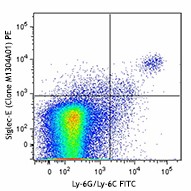
-

C57BL/6 mouse splenocytes were stained with Ly-6G/Ly-6C (clone Gr-1) FITC and Siglec-E (clone M1304A01) PE (top) or rat IgG2a, κ PE isotype control (bottom). -

| Cat # | Size | Price | Quantity Check Availability | Save | ||
|---|---|---|---|---|---|---|
| 677103 | 25 µg | 123€ | ||||
| 677104 | 100 µg | 288€ | ||||
Siglecs (sialic acid binding Ig-like lectins) are type I membrane proteins with an extracellular region containing a sialic acid binding V-set Ig-like domain at the N-terminus, followed by varying numbers of C2-set Ig domains. The cytoplasmic tails of all siglecs have tyrosine based motifs with a signaling function. Siglecs are widely expressed on hematopoietic cells, often in a cell-type-specific manner. Their ligands, sialic acids, are negatively charged monosaccharides found on cell-surface glycoproteins and glycolipids. Studies suggest that siglecs may participate in cell-cell interactions or act as receptors for the entry of viral or bacterial pathogens. In addition, the presence of immunoreceptor tyrosine-based inhibitory motifs (ITIM) in their cytoplasmic domain indicates that these molecules may play a role in the suppression of immunoreceptor signaling. Siglec-E is a mouse CD33-related siglec that selectively regulates early recruitment of neutrophils to the lung in acute lung inflammation induced by lipopolysaccharide. Siglec E-deficient mice exhibit exaggerated neutrophil recruitment that is reversible by using a blockade of the β2 integrin, CD11b. In addition, sialidase treatment of fibrinogen reverses the suppressive effect of Siglec-E on CD11b signaling. This suggests that sialic acid recognition by Siglec-E is required for its inhibitory function. These findings indicate that Siglec-E is an important negative regulator of neutrophil recruitment to the lungs and β2 integrin-dependent signaling.
Product DetailsProduct Details
- Verified Reactivity
- Mouse
- Antibody Type
- Monoclonal
- Host Species
- Rat
- Immunogen
- Recombinant mouse Siglec-E produced in the HEK293A cell line.
- Formulation
- Phosphate-buffered solution, pH 7.2, containing 0.09% sodium azide.
- Preparation
- The antibody was purified by affinity chromatography and conjugated with PE under optimal conditions.
- Concentration
- 0.2 mg/ml
- Storage & Handling
- The antibody solution should be stored undiluted between 2°C and 8°C, and protected from prolonged exposure to light. Do not freeze.
- Application
-
FC - Quality tested
- Recommended Usage
-
Each lot of this antibody is quality control tested by immunofluorescent staining with flow cytometric analysis. For flow cytometric staining, the suggested use of this reagent is ≤0.25 µg per million cells in 100 µl volume. It is recommended that the reagent be titrated for optimal performance for each application.
- Excitation Laser
-
Blue Laser (488 nm)
Green Laser (532 nm)/Yellow-Green Laser (561 nm)
- Application Notes
-
This antibody works for western blotting under non-reducing conditions.
-
Application References
(PubMed link indicates BioLegend citation) -
- Siddiqui S, et. al. 2017. J. Biol. Chem. 292: 1029.
- RRID
-
AB_2566168 (BioLegend Cat. No. 677103)
AB_2566169 (BioLegend Cat. No. 677104)
Antigen Details
- Structure
- 569 amino acids with a predicted molecular weight of approximately 65 kD.
- Distribution
- Siglec-E is expressed mainly on neutrophils in blood and their immature precursors in bone marrow, on tissue macrophages, on subsets of mature natural killer cells, splenic dendritic cells, and on monocytes as well.
- Function
- Siglec-E regulates neutrophil recruitment. Siglec-E signaling negatively regulates the LPS-induced production of TNF-α and IL-6 by macrophages. It is upregulated by a variety of TLR agonists.
- Ligand/Receptor
- Siglec-E binds broadly to sialic acid-containing glycans. It prefers alpha 2,8-linked sialic acid over alpha 2,6 and alpha 2,3.
- Cell Type
- Neutrophils, Macrophages, NK cells, Dendritic cells, Monocytes, B cells
- Biology Area
- Cell Biology, Immunology, Innate Immunity, Signal Transduction
- Molecular Family
- Siglec Molecules
- Antigen References
-
1. McMillan SJ, et al. 2013. Blood 121:2084.
2. Bax M, et al. 2010. Ann. Rheum. Dis. 69:42.
3. Angata T and Varki A. 2000. J. Biol. Chem. 275:22127.
4. Zhang JQ, et al. 2004. Eur. J. Immunol. 34:1175.
5. Yu Z, et al. 2001. Biochem. J. 353:483.
6. Claude J, et al. 2013. J. Neurosci. 33:18270.
7. Chang YC, et al. 2014. PLoS Pathog. 10:e1003846.
8. Laubli H, et al. 2014. Proc. Natl. Acad. Sci. USA 111:14211.
9. Schwarz F, et al. 2015. eLife 4:e06184. - Gene ID
- 83382 View all products for this Gene ID
- UniProt
- View information about Siglec-E on UniProt.org
Related Pages & Pathways
Pages
Related FAQs
- What type of PE do you use in your conjugates?
- We use R-PE in our conjugates.
Other Formats
View All Siglec-E Reagents Request Custom Conjugation| Description | Clone | Applications |
|---|---|---|
| Purified anti-Siglec-E | M1304A01 | WB,FC,IHC-F |
| PE anti-Siglec-E | M1304A01 | FC |
| APC anti-Siglec-E | M1304A01 | FC |
| PE/Cyanine7 anti-Siglec-E | M1304A01 | FC |
| FITC anti-Siglec-E | M1304A01 | FC |
| PerCP/Cyanine5.5 anti-Siglec-E | M1304A01 | FC |
Customers Also Purchased


Compare Data Across All Formats
This data display is provided for general comparisons between formats.
Your actual data may vary due to variations in samples, target cells, instruments and their settings, staining conditions, and other factors.
If you need assistance with selecting the best format contact our expert technical support team.
-
Purified anti-Siglec-E
Western blot analysis of wild type mouse spleen (lane 1) and... -
PE anti-Siglec-E
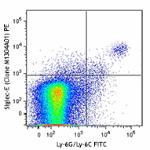
C57BL/6 mouse splenocytes were stained with Ly-6G/Ly-6C (clo... 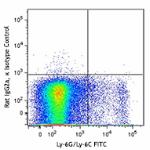
-
APC anti-Siglec-E
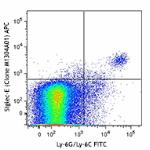
C57BL/6 mouse splenocytes were stained with Ly-6G/Ly-6C (clo... 
-
PE/Cyanine7 anti-Siglec-E

C57BL/6 mouse splenocytes were stained with Ly-6G/Ly-6C (clo... -
FITC anti-Siglec-E

C57BL/6 mouse splenocytes were stained with Ly-6G/Ly-6C APC ... 
-
PerCP/Cyanine5.5 anti-Siglec-E

C57BL/6 mouse splenocytes were stained with Ly-6G/Ly-6C APC ...
 Login / Register
Login / Register 









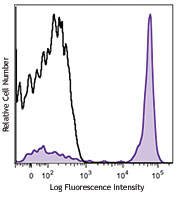





Follow Us